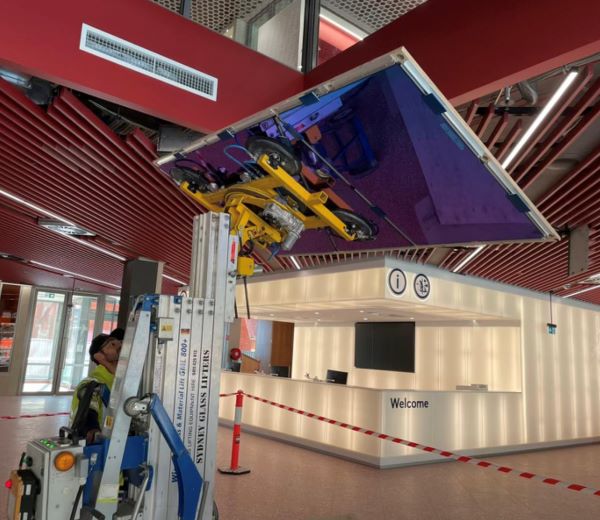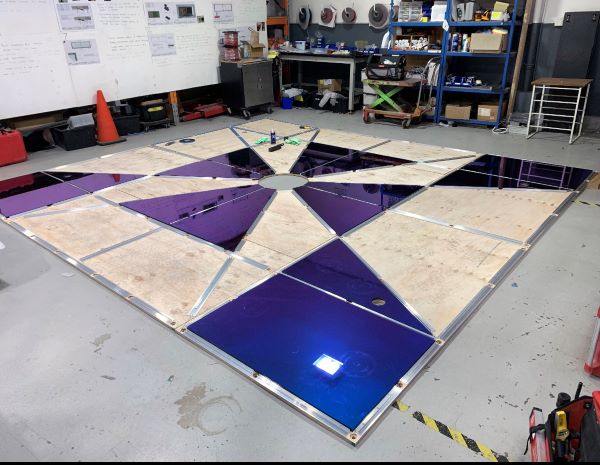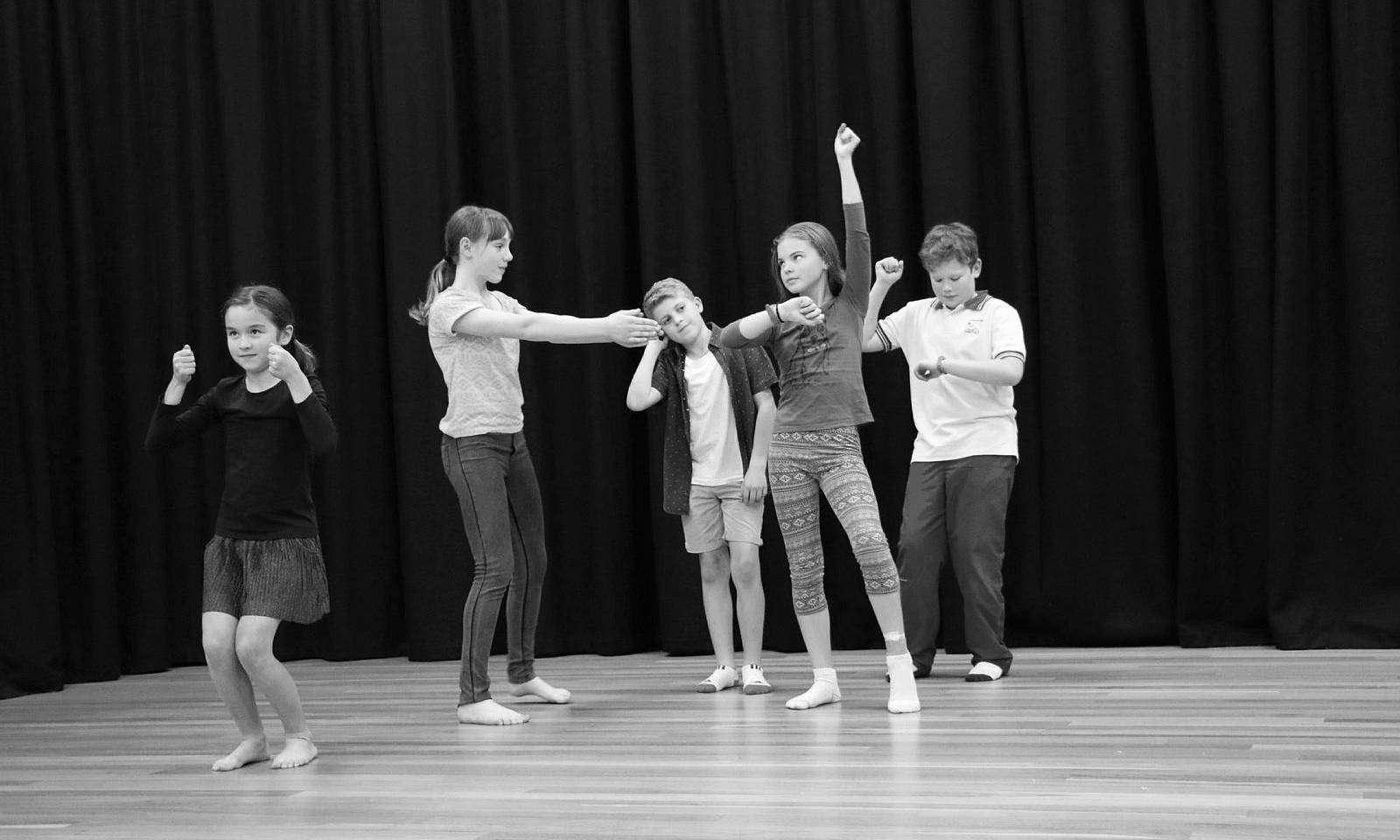Parramatta River, Ripples and Concentric Circles
Water is essential to life and human history tells us that thriving civilisations are born around the riverbanks. Syed’s affinity for water resonates with the history of the first known residents along the Indus River in Sindh, Pakistan, the Mohenjo-Daro (part of a larger culture known as the Harappans), and with Parramatta River and its waterways, its Indigenous people and evolving culture. The Parramatta River’s ecosystem sustains remarkable mangrove trees that remind him of the endangered mangrove forests on Karachi’s coast, where the artist was born and raised. As someone bound to public transport, Syed uses Sydney City Rail and Ferry to commute and has memorised the sight, sound, and fragrance of the Parramatta River and its surrounding environment.
Ripples and concentric circles are significant recurring images in Syed’s art practice. The artist remembers throwing stones to make them run on the water’s surface and recognises these ripples as a mystical concept of connection and enlightenment, from which concentric circles appear as the growth pattern of life. One can measure them by the growth rings in tree trunks, the bloom pattern of flowers, the movement of waves, the water molecule, our human DNA, and even the rings of archery targets that Syed utilises in his works.
Parramatta and PHIVE: Personal Links and Narratives
Pakistani born artist Abdullah M.I. Syed has a personal connection to PHIVE, having moved to Australia in 2006 to reside and work in western Sydney. Parramatta is a valuable platform to learn more about Australian culture and share his Pakistani Muslim heritage with the community. As an artist, designer, curator and scholar of the Pakistan’s diaspora, Syed is both an Australian and cross-cultural voice. In a sense, Syed sees his community role as an artistic liaison of cross-cultural dialogue.
Syed’s connection with Parramatta and PHIVE began with an artist residency at Parramatta Artists’ Studios (PAS) in 2012, where his studio looked out to the (future) PHIVE site. In 2015, he established a studio in the Queensland Arcade building. From his studio window, Syed observed the vibrant life of Parramatta Square. As a user of public transport, he has developed an affinity with the Parramatta River and its surrounding environs. He often photographs his surroundings as a visual testimony of Parramatta’s transformation and growth.
Understanding the community’s location within a diverse social, mystical, artistic, and environmental ecology affirms his commitment to supporting culturally and linguistically diverse communities and informs his artwork commission for PHIVE.
Geometry and Patterns: From Islamic Art to Water Structure and Science
Syed utilises geometric patterns, a non-figurative type of decoration in Islamic art which also includes calligraphy and botanical and rhythmic linear patterns known as arabesque. (Blair, Shelia., et al. The Art and Architecture of Islam, 1240-1800. New Heven [Conn.], Yale University Press, 1994). The basic shapes of circles, squares, and triangles each have a meaning and value which encompass the Islamic idea of unity. A square represents earth or materiality, a triangle symbolizes human conscientious, and a circle suggests that time can compose of finite instants and beginnings. Geometric tessellated patterns have become one of the most distinguishing features of Islamic art and when repeated form complex patterns such as stars and rosettes. These structures informed Syed’s representation of a water molecule cluster where hydrogen and oxygen molecules resemble a lattice geometric pattern.
The suspended sculpture embodies six-fold division geometry which produces overlapping ripples and waves that ‘move’ within a twelve-petal-like pattern. The number twelve represents the twelve months of the Islamic and Georgian calendars, and the symmetrical lines and concentric circles infer Islamic patterning. Their creation is tied directly to the Islamic mystical arts and its commitment and “affirmation of unity as expressed in diversity.” (Critchlow, Keith. Islamic Patterns: An Analytical and Cosmological Approach. Thames & Husdon,1993)
Mughal Architecture of Pakistan, PHIVE Roof Design and Colour Pallet
The design of Syed’s angled dichroic glass ceiling is inspired by his connections with the Mughal architecture, specifically the Sheesh Mahal or ‘Mirror Palace’ in Lahore, Pakistan. Syed first visited the Mirror Palace as a teenager and has since admired it for its craft and many legends. The most important feature of this monument consists of a white marble pavilion that contains beautiful inlayed stonework, glass mosaic work, and stucco tracery. The mirror mosaic craft, ayina kari, was applied onto the interior walls and ceilings to create multiple reflective images of the onlooker. Ayina kari craft is considered as one of the finest examples of Mughal Islamic geometric pattern design and architecture. (Muhammad, Kamran., et al. History of Conservation of Shish Mahal in Lahore-Pakistan. IJRCMCE Vol. 3, Issue 1, 2016. Pg. 10.)
The Mirror Palace was commissioned by Mughal Emperor Shah Jahan in 1631 as a physical manifestation of his beloved Queen Mumtaz Mahal floating so high that she could touch the stars. Syed’s many visits to the palace in Lahore profoundly impacted his artistic training and understanding of the mystical concepts of divine love and presence. His PHIVE creation of multiple mirrored reflections highlights his desire to profoundly connect with and reflect the world around him.
PHIVE’S colourful tessellated roof design - a pattern of more than one shape which completely covers an entire plane – triggers Syed’s memories of Sheesh Mehal’s ceiling. The warm colours of the PHIVE roof are complemented and strengthened by the cool blue tones in Syed’s glass ceiling.
The floor sculpture is a manifestation of the mystical concept of striving to reflect inner calm and beauty. The large mirror positioned on a plinth provides an opportunity for the public on the ground level to interact and include their reflection in the work as they explore reflections of the ‘sky’ - Universe and Matrix – above while their face appears in the mirrored reflection ‘water’.
Installation Components

The Universe (Angled mirrored celling)
Pattern: Islamic Geometrical pattern of 12-points star tessellation
Material/Technique: Dichroic mirror and laminated glass

The Matrix (Suspended glass and acrylic elements)
Pattern: Scientific pattern of the universe expansion, Islamic geometrical pattern of rosette, fractal pattern of the water molecule cluster
Material/Technique: Acrylic segments, with blown and cast glass:

The Iris (Floor sculpture)
Pattern: Infinite mirror reflection
Material/ Technique: Solid surface material ‘Corian’.
Production Notes: Materials and Techniques
Abdullah M.I. Syed worked with Tilt Industrial Design and Gallery Sally Dan Cuthbert in Sydney to bring his vision to life. The sculpture is a complex arrangement of forms and uses diverse materials with contemporary manufacturing techniques. The concept was developed through hand sketches before digital development and computer modelling before manufacture.
Laminated glass with vaporised micro-layers of quartz crystal and metal oxides make-up the dichroic background colours of the Universe.
A CNC machine milled the ripples in the cast acrylic segments of the Matrix. Hand-blown glass produced the droplet form at the centre of the Matrix, and glass casting techniques were used to create the translucent blue triangular elements embedding the acrylic segments. A powder coated mild steel armature provides mechanical support to the suspended elements of the Matrix.
CNC machining and vacuum forming processes were applied to the ‘Corian’ material of the Iris to create the plinth that supports the translucent blue and mirrored glass surface.
Gallery
(Back to top)Image Gallery
The Artist behind Ripple Effect
-
Abdullah M.I. Syed’s interdisciplinary art practice champions the power of storytelling from a cross-cultural perspective. Speaking to present-day circumstances, his Pakistani Muslim heritage, artistic research interests, and the influences of his everyday experiences – lived outside and inside a diasporic space – Syed creates art forms of poetic ‘resistance’ or manzoom muzahamat, which subvert dominant power structures to create social change. Working at the intersection of drawing, sculpture, video, textile, photography and performance, Syed highlights the economics of shared histories, identity, vulnerability and resilience.
-
Abdullah M.I. Syed
Ripple Effect, 2022
Cast and blown glass, dichroic and polished mirror, acrylic, Corian and powder coated steelInspired by the Parramatta River, Parramatta’s diverse community and the artist’s links with Western Sydney, Ripple Effect, celebrates the art of storytelling across generations. Like the ripples in water, the artwork suggests how our thoughts, voices and actions reverberate throughout the universe, transferring knowledge and forming infinite patterns of contemplation.
Ripple Effect, was commissioned by the City of Parramatta and is situated in the ground floor foyer of PHIVE - City of Parramatta’s new community, cultural and civic hub in Parramatta’s CBD. It is composed of three parts: the Universe (angled mirrored ceiling), the Matrix (suspended glass and acrylic sculpture), and the Iris (floor sculpture). The installation is a convergence of light, colour and geometry creating an interactive and reflective space. Referencing the structure of water molecule clusters, the geometric patterns in Islamic art, the Mughal architecture of Pakistan and the tessellated design of PHIVE’S roof, the artwork evokes the complex histories of Parramatta as a place for communities to connect, learn and thrive.
-
Syed has exhibited and performed nationally and internationally: Art Gallery of New South Wales, Sydney; Gallery Sally Dan Cuthbert, Sydney; TIFF Bell Lightbox, Toronto, Canada; Asian Society Museum, and Aicon Contemporary, New York, USA; Pataka Art + Museum, Porirua City, New Zealand; Devi Art Foundation, Gurgaon, India; the National Art Gallery, Islamabad, Pakistan; and the Mohatta Palace Museum, Karachi, Pakistan; among other venues. Syed is a recipient of the NAVA Carstairs Prize (2017), Blacktown City Drawing Art prize (2010), and IAO Installation Artist award (2003), Oklahoma, USA. He has undertaken several artist residences in Sydney including Blacktown Arts Centre (2011), Parramatta Artists’ Studios (2012-2015) and Artspace (2019). In 2022, Syed also completed the Transport NSW’s public sculpture commission for the façade of Warwick Farm Commuter Car Park, Sydney, Australia. Syed earned a PhD in Art, Media, and Design (2015) from University of New South Wales, Sydney. He lives in Sydney and works between Australia and Pakistan.
Abdullah M. I. Syed is represented by Gallery Sally Dan-Cuthbert, Sydney.
-
Artist and Designer:
Abdullah M. I. SyedCommissioner:
City of ParramattaRepresentative Art Gallery:
Sally Dan-Cuthbert, Director, Gallery Sally Dan-Cuthbert, SydneyParramatta City and PHIVE Research:
Abdullah M. I. Syed, Tim Phillips and Chris BarlinResearch and Western Sydney Community:
Abdullah M. I. Syed (Lived experience of a migrant in Western Sydney)
Umme Sajid and Sajid Ali Family, South Asian and Islamic community liaison
Sophia Kouyoumdjian, Parramatta Artists Studios
Khaled Sabsabi, eleven collective
Katherine Knight (Passion, Purpose & meaning – Arts Activism in Western Sydney, Halstead Press, 2013)
Also
Migrant communities in Parramatta City Council, Blacktown City Council and Liverpool City Council.
And community galleries and centres such as Blacktown Arts Centre, Campbelltown Arts Centre, Fairfield City Museum and Gallery, Casula Powerhouse Art Centre, Penrith Regional gallery, Masjid Qubba (Mount Druitt), Rooty Hill Mosque and Parramatta Mosque.Islamic pattern and Mughal architecture of Pakistan Research:
Abdullah M. I. Syed (Art of Barzakh, The Poses, Props and Performances of Masculinity in Pakistani Art, UNSW, 2015).
Kamil Khan Mumtaz (Modernity and Tradition and Architecture in Pakistan)
Kamran Muhammad (History of Conservation of Shish Mahal in Lahore-Pakistan, 2016).
Keith Critchlow (Islamic Patterns: An Analytical and Cosmological Approach, 1993).
Shelia Blair (The Art and Architecture of Islam, 1240-1800).Production Advisors (Materials and Technique):
Sally Dan-Cuthbert and Tim PhilipsPublic Art Project Manager City of Parramatta:
Suzanne Buljan, Senior Officer, Cultural Projects and Public Art, PHIVE ProjectProject Advisors and Facilitators:
Sophia Kouyoumdjian, Director Parramatta Artists’ Studios and Cultural Services
Sally Dan Cuthbert, Director Gallery Sally Dan-Cuthbert, Sydney
Salma Ehsan CheemaProcess Photography and Video:
Abdullah M. I. Syed, Tim Phillips and Chris BarlinVideo editing:
James Wood, Storyboard Media.Production and Design Collaborators:
TILT Industrial Design: Tim Phillips, Chris Barlin, Kieran Barker, Elizabeth Lewis and Craig Healey and interns.Technical design and manufactures:
Robert Wynne & Yuri Wynne, Denizen Glass Studio, Sydney
Jennifer McIver, Sydney Glassworks, Sydney
Industri-Man
Sydney Installations
Germax InteriorsEditors (Text): Abdullah M. I. Syed, Sally Dan Cuthbert, Suzanne Buljan, Sophia Kouyoumdjian and William Brereton
I would like to acknowledge the continued support of my parents Syed Talha and Late Azra Waseem; wife Salma E. Cheema; siblings specifically sister Umme F. Sajid and husband Syed Sajid Ali; the amazing team of my representative gallery in Sydney, Gallery Sally Dan Cuthbert and my mentors James R. Watson, Michael Esson, and Bonita Ely who have helped shape my career and are a constant source of encouragement and dua (prayers). I am also so very thankful for the practical and constructive support of Sally Dan Cuthbert, Sophia Kouyoumdjian, Matt Cox, Alexie Glass-Kantor, Toby Chapman, Pedro D’Almeida, Khaled Sabsabi, Tazeen Qayyum, William Brereton, Tim Phillips, Chris Barlin, Kieran Barker, Elizabeth Lewis and Suzanne Buljan without which, this project could not have been realised. Sukriya!



